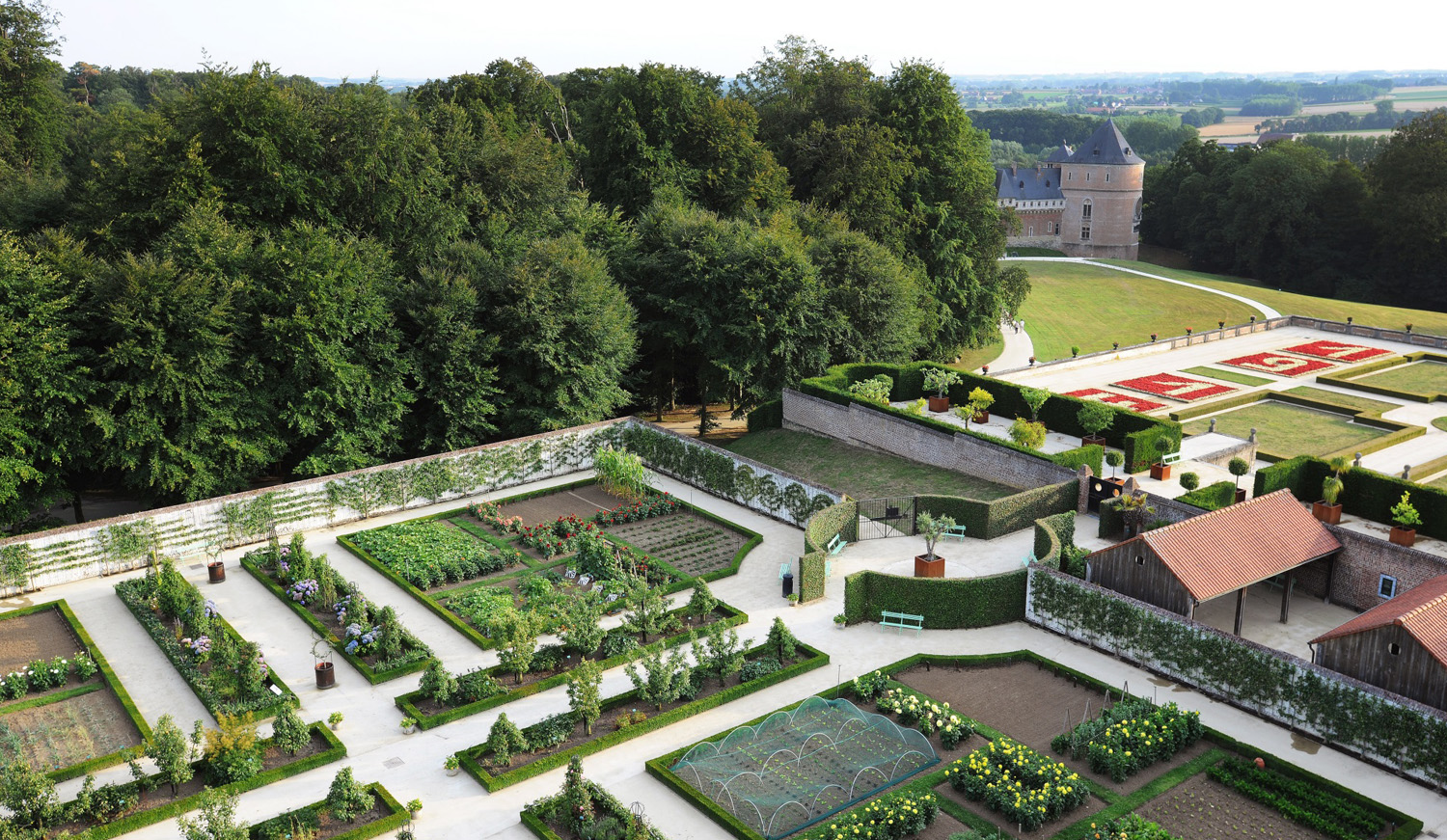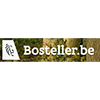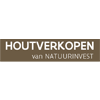
Museum garden Gaasbeek
Ornamental and functional
This is a completely newly built garden, specially designed to suit its purpose as a museum garden. The garden is situated on a historical site where gardens existed in the past. It is made up of six garden sections:
- A terrace garden with an Italian-style orangery garden.
- A kitchen garden, divided into four squares, with a greenhouse, cold frames and beds for flowers and herbs. In the middle is a cloister with low standard pyramid-shaped pear trees, flat-lying garlands and rose columns.
- Berry and fig gardens, with a cross-shaped arbour with an abundance of espaliered fruit and flowers.
- An orchard with a regional collection of half standard plum trees.
- An orchard with full standard fruit trees, typical of Pajottenland fruit farming circa 1900, with a traditional fruit shed.
- An orchard with low standard trees showing how cultivation practices have evolved over time from around 1950 to the present.
Espaliered fruit grows up against all the walls in a range of varieties, representing the largest collection of traditional espalier shapes. The fruit baskets are really something to behold.
In 2012, the Museum Garden was the only garden in Flanders to be awarded the EGHN, the European Garden Award.
Working miracles on a limited amount of space
The Museum Garden proves that you really don’t need a lot of space to grow your own fruit and vegetables. You can grow several fruit trees along one town wall. In the spring, their blossoms will brighten up your garden, then in summer you can enjoy the fruit. In the autumn, their leaves turn that gorgeous yellow and red colour. Even if the amount of public space is limited, you can work wonders on a small surface area.
The Museum Garden attaches great importance to the nearly forgotten art of espaliered fruit cultivation, involving varieties of apricot, nectarine, peach, plum, pear, apple, quince, sweet cherry, sour cherry and many berry varieties. Espaliered fruit farming offered a wide range of benefits at a time when labour was cheap.
- Espalier shapes need little in the way of space, and grow a treat up against walls or as hedges.
- They will grow in a kitchen garden without getting in the way of the vegetables.
- They are pruned in such a way that most of the energy goes to fruiting. No excess branches, no superfluous foliage, you can even ‘save’ the trunk. The trees remain upright because they are tied to a wall or trellis.
- Espaliered fruit ripens on ‘open’ trees, which means the fruits get more sunlight and consequently contain extra sugars and vitamins.
- Tying against a wall gives them added protection against the cold and they can benefit from the heat stored in the wall. The fruits are larger and more appetising, quicker to ripen and more resistant to disease.
- Creative master gardeners can make espalier shapes look beautiful by forcing stalks and branches to take on the wildest shapes and causing them to interweave. Imaginative shapes made to look like living lacework.
Own climate
The Museum Garden has a special micro climate. Temperatures are invariably a few degrees higher than the surroundings. A normal winter only sees a limited number of frost days inside the walls. But it is more important that spring temperatures in the garden are higher, and that things stay warm for longer during autumn. This micro climate comes courtesy of the high walls and hedges that protect against the chilly winds, white walls that reflect the heat of the sun, the bricks that act as heat collectors and the Pajottenland soil which contains a lot of heavy clay that stores heat.
Visit
You can buy your ticket at the entrance building on Kasteelstraat. Combination tickets are then also available to combine your visit to the Museum Garden with a visit to Gaasbeek Castle. You can pay with bank card or cash. Be sure to take a look in the shop as well.
Dogs are not allowed in the Museum Garden.
Opening hours
- From 1 May to 30 September, daily from 10 a.m. to 6 p.m.
- From October 1 to October 31, daily from 10 a.m. to 5 p.m.
- The garden is closed every Monday, except on public holidays.
Tickets
You can buy your tickets at the entrance building on Kasteelstraat. Combination tickets are then also available to combine your visit to the Museum Garden with a visit to Gaasbeek Castle. You can pay with bank card or cash. Be sure to take a look in the shop as well.
- Standard: € 7
- Concessions: € 6 - students under 27, European Youth Card under 26, 65+ and groups +10 people
- Free: -18, National Trust and disabled and their accompanist
- Groups visiting the Museum Garden with a guide pay € 60 per guide and € 6 per participant (other discounts are not valid)
Guided tours
Together with the guide, discover the different parts of the Museum garden: the orchards, small fruit garden, vegetable garden, shadow garden and ornamental garden. You will learn about forgotten fruits and vegetables and learn more about the ingenious pruning and slate shapes that you can admire in the garden. Through anecdotes about the history of the region and the Flemish gardeners and fruit growers you will be taken along in a fascinating and educational story.
Guided tours are possible for groups of up to 15 people. So keep in mind that you may need to book several guides for your group. A tour for your group takes an hour and a half and costs € 60 per guide + € 6 per visitor. The level of the tour is always adjusted to your group. You pay the cost of the guide together with the entrance tickets before the start of the tour. Reservation is mandatory and must be submitted 4 weeks in advance.
Fill out this form to request one or more guides. We will contact you to confirm the tour(s). Any questions? Send an email to gidsbeurtenmuseumtuin@gmail.com.
Your group will be met by the guide half an hour before the start of the tour at the entrance building on Kasteelstraat. There you will settle the guide tour and tickets at the counter. Together with the guide, you will walk to the Museum Garden for the tour.
Allow at least an hour and a half for the guided tour.
Events
- FRIDAY, AUGUST 15, from 2:00 PM to 4:30 PM
VENETIAN PROCESSION FROM GROENENBERG TO GAASBEEK
Come and spend an enchanting afternoon in the magnificent museum garden! For the sixth time, we will welcome dozens of brilliantly dressed Venetian figures who will transform the garden into a truly magical spectacle.
At 2:00 PM, the figures will gather at Groenenberg Castle for a group photo. Afterwards, the colorful procession will depart from Groenenberg Castle and pass through Groenenberg and Gaasbeek Parks to the Garden Museum. You can admire them from the side of the road.
Would you like to admire them up close? Come to the Garden Museum. From 3:00 PM to 4:30 PM, you can have your picture taken with these mysterious figures. You must have an admission ticket for the Garden Museum.
You can purchase it on the day at the park entrance or in advance on the website. Tickets cost only 7 euros for adults, 6 euros for concessions, and children go free!
For those who fancy a drink, there's a welcoming regional bubble bar in the garden.
- SUNDAY, SEPTEMBER 14, from 10:00 AM to 5:00 PM
GARDEN-MUSEUM DAY
As we do every year, we open the doors of the Garden-Museum for Heritage Day. Everyone is welcome to visit free of charge on this day, from 10:00 AM to 5:00 PM.
Fruit tastings from the garden, guided tours (NL + FR), fun activities for children, regional market, bar, ...







